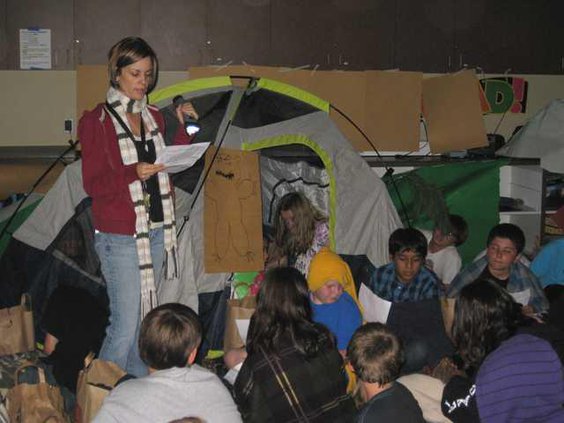An English writing project recently allowed Oakdale Junior High School students to go camping in the wilderness – while staying at school.
As a creative way to meet writing standards, OJHS Language Arts teachers Danesa Jepson, Lori Vargas, and Jenny Ferguson planned a “sensory day” for their students to help them develop skills in writing specific details. A dark, chilly classroom, a tent, some pine boughs and pinecones, flashlights, and cold weather attire helped provide the backdrop for the sensory day in the wilderness.
“(The students) are given a list of things to bring but they don’t know where they’re going or what they’ll be experiencing,” Ferguson explained.
Some of the items they were asked to bring were blankets, sweatshirts, s’mores, and packets of hot chocolate for the day.
The teachers followed a script that touched on each of the five senses by using the items that the students had brought and a few other props as well. As they played recorded sounds of crickets and howling wolves, they told students to describe what they hear. The talked to them about the chill in the air and tossed crushed ice over the crowd as “snow.” They asked what the s’mores tasted like, smelled like, and sounded like.
“(Having the props), it helps you describe things better because it’s all visual, you can feel it, and you can touch it,” said eighth grader Alexes Starkweather.
The students practiced using their five senses and charted them using descriptive, specific words. Describing rather than telling brings more color, or life, to the students’ writing.
“One of their standards is to be able to use descriptive writing in a narrative,” Ferguson said.
The students spent 20 to 30 minutes in the “wilderness,” taking in the experience and writing down their thoughts, then they went back to their classrooms to write more and share some descriptions with their class.
“They get the experience of it,” Jepson said. “One student had never gone camping before… It’s nice to let students have that experience…and their writing gets substantially better.”
Providing a vivid picture of what they’re experiencing or seeing in their own mind is a goal of the project. Jepson added that the students did some practice assignments in the weeks leading up to the sensory day.
Jepson and Vargas got the idea from a conference workshop that focused on how to make writing more creative and real for students. The teachers have also alternately done a “day at the beach” for sensory day.
Senses Used To Help Students Write Creatively





